It’s estimated there are more than 400 bee species in New York. More than half of these species are digger bees that nest in the ground.
Most bees in New York don’t seek out to sting people. Paper wasps, carpenter bees, and honey bees are common alongside various species of digger bees. The most common species are the following.
Table of Contents
1. Common Eastern Bumble Bee
The Common Eastern Bumble Bee (Bombus impatiens) is the most common species in New York. These bumble bees are common throughout the East Coast.
Identified by their yellow-black hairy bodies, these bees are known as some of the most important local pollinators.

The bees collect dusty pollen with their hairy bodies which they transport from flower to flower.
The Common Eastern Bumble Bee is one of the many New York species to nest unground.
It builds complex underground nests with a social cast division. Worker bees are responsible for nest maintenance but they have been shown to keep a clear distance from the center of the nest.
These bees have a varied diet. They can eat raw plant materials such as pollen.
However, the Common Eastern Bumble Bee prefers to eat the honey it produces.
These bees are known to produce honey by mixing pollen with saliva and digestive system enzymes which are then regurgitated.
Common in all types of temperate climates, these bees live together in nests.
A typical Common Eastern Bumble Bee nest is comprised of 300 to 500 bees.
2. Western Honey Bee
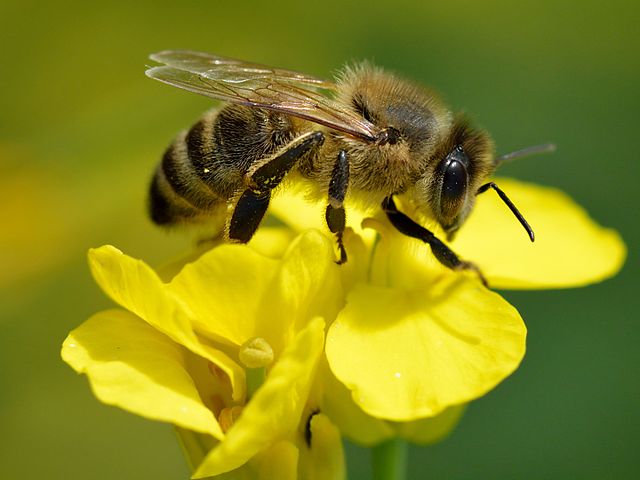
The Western Honey Bee (Apis mellifera) is one of the most important honey-producing species in the world. It’s largely found in New York where beekeepers manage its colonies.
Western Honey Bee has an important role in crop pollination, honey production, and beeswax production.
These bees are known for their colony-type structure which means they can only survive as colonies.
Western Honey Bee colonies are more important than individual bees as they survive from one season to another.
Western Honey Bees replicate colonies by the process of swarming. This means one colony divides into 2 or more colonies as it grows.
Establishing new colonies typically happens in the summer. These bees survive winter if properly fed.
Western Honey bees are known for their large honey production. They also make beeswax which is secreted by a gland in their abdomens.
3. Brown-belted Bumble Bee

The Brown-belted Bumble Bee (Bombus griseocollis) is native to much of the US. This bee species is found in large numbers in New York.
It’s identified by its yellow thorax, black abdomen, and a thin red-brown line around its abdomen that inspires its name.
These bees grow to a size of 0.3 to 0.5 inches when it comes to males and worker bees. They follow a larger queen which is responsible for building nests and establishing small colonies.
Brown-belted Bumble Bees live together in small underground colonies.
Up to 50 bees can be found in these underground nests.
These bees are very common pollinators of urban and suburban gardens in New York.
Brown-belted Bumble Bees are adapted to living in urban areas such as New York, unlike many other bees.
They show attraction towards a series of plants found in urban gardens such as milkweeds and various clovers.
4. Eastern Carpenter Bee

The Eastern Carpenter Bee (Xylocopa virginica) is a type of species that nests in various types of wood. It’s found around New York and other temperate climates.
Eastern Carpenter Bees are adapted to living together in nests even if they aren’t known for similar co-dependency as other honey bees.
The Eastern Carpenter Bee is one of the most important pollinators of decorative plants. It doesn’t have a significant role in agriculture, as a result.
Blueberry pollination is the sole exception when it comes to the role of the Eastern Carpenter Bees.
Furthermore, these bees are known to feed pollen to their young.
The Eastern Carpenter Bee can sting and its results are generally painful to humans. However, it’s just the female bees that can sting.
Males are known to play a role in reproduction and the patrolling of the nests.
These bees can also have a destructive role. Like carpenter bees, they tend to nest in wood.
Eastern Carpenter Bees can sometimes have a destructive role on homes, but lower compared to other potentially-destructive species.
5. Two-spotted Bumble Bee

The Two-spotted Bumble Bee (Bombus bimaculatus) is common around woodlands and parks. These bees get their name from the two dark spots visible on their yellow thorax.
Both male and female bees have these dark spots which help distinguish between them and other similar species.
Like bumble bees, they live socially around a single queen which builds nests and colonies.
Flight season is long, from May to September. Queens emerge first seeking a place to lay eggs in and establish a nest with the first cast of worker bees.
These bees are medium-length tongue bees which means they’re after similar plants and flowers as other bumble bees.
The Two-spotted Bumble bee is primarily interested in thistles, sweet clovers, and bee balms.
Male Two-spotted Bumble bees also stand out from other male bees as they have been shown to care for emerging larvae in the first few days.
While females remain responsible for feeding nectar to broods, males get involves as well.
It’s believed males care for Two-spotted Bumble bee broods as a means to exercise their muscles.
Young males aren’t able to easily fly for the first few days as they emerge. This is when they remain in or around the nest when they help with brood care.
6. Ligated Furrow Bee

The Ligated Furrow Bee (Halictus ligatus) is widespread in temperate climates. This bee has golden, black, and brown coloring. It’s also smaller than honey bees.
These bees are part of the sweat bee family which means they follow people around and they land on exposed skin.
Nesting in the ground, the Ligated Furrow Bee is subject to a clear hierarchy which is often challenged by inner-nest aggression.
Only foundress female bees survive to overwinter and they are generally larger than other bees of the species.
It’s believed these bees are larger as they need to conserve more energy to survive the winter months.
Ligated Furrow Bees are general pollinators. They consume pollen themselves and they have a general pollination role.
There’s constant aggression between female worker bees and the queen foundress bee in this species.
Conflicts arise as female worker bees try to lay their eggs and provision for the offspring. Almost half of these worker bees succeed in producing their offspring.
7. Pure Green-Sweat Bee

This Metallic Green Bee species (Augochlora pura) is known for living without a social cast. Females establish nests of their own.
Adapted to nesting in decaying wood, these bees are always dealt with by removing all old pieces of wood from a New York house.
Pure Green-Sweat Bees need decaying wood to build long nests with individual chambers where eggs are laid.
These chambers are further provisioned with pollen. Only a small percentage of the collected pollen is consumed by adult Pure Green-Sweat bees while most go to offspring.
The species also has multiple natural predators. Spiders who eat bees are among the species’ most prevalent predators.
Female bees can live long lives when not falling to predators. Up to 20 nests can be established by female bees in their lifetime.
8. Golden Northern Bumble Bee

The Golden Northern Bumble Bee (Bombus fervidus) is also known as the Yellow Bee. The species is native to North America and prevalent in New York.
Bees of the species are identified by their yellow thorax and yellow abdomen.
Drones have an average body size of 10-11mm. Female worker bees have an average body length of 10.5. Queen bees can grow up to 21mm and they can be fed by worker bees.
Golden Northern Bumble Bees routinely sting people. It’s best to avoid handling these bees as they have a painful sting.
Otherwise, they are helpful pollinators for flowers and crops. Adult Golden Northern Bumble Bees are nectarivore which means they only eat nectar.
Broods are fed pollen which is collected and mixed with saliva by adult bees.
The species is known to create nests where it lives communally. These nests are mostly made out of feces and plant fiber.
Each nest has individual cells for bee eggs.
These nests can number at least tens of bees but they are larger the closer the nest is to crops or flowers as food sources.
9. Bicolored Striped Sweat Bee

The Bicolored Striped Sweat Bee (Agapostemon virescens) gets its name from its dual color body. Its upper body is metallic green while the lower body is striped with either yellow and black or white and black for males and female bees.
The species is known to nest underground. It is one of the species that can live both social lives and solitary lives.
Bicolored Striped Sweat Bees are known to share the same nest but live in different areas of the nest. They use the same nest entrance but they prefer to create their chambers inside the underground nest.
Multiple generations of bees emerge each summer. It’s the last generation of a season that establishes the first generation of emerging bees for the following season.
10. European Woolcarder Bee
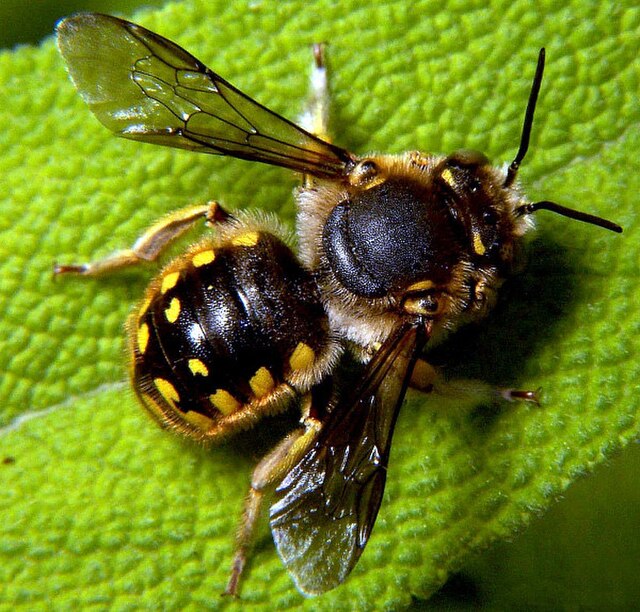
The European Woolcarder Bee (Anthidium manicatum) has been accidentally introduced to the US from Europe through New York.
It was first identified in 1963 in areas of New York. Since then, this species has spread out all around the Northern part of the country.
Bees of the species can be identified by their wide black and yellow body.
Females have a body length between 14 and 17mm while males have a body length of 11 to 13mm.
These bees have a few distinct traits such as nesting in pre-existing nests of other species. They also use plant fibers to repair nests and lay eggs on.
The European Woolcarder Bees are also among the species that exhibit polyandry mating habits. Female bee mates with multiple male mates through a reproductive cycle.
11. Tricolored Bumble Bee

This species (Bombus ternarius) gets its name from the 3 colors of its body. These are black, orange, and yellow making for easy species identification.
Tricolored Bumble Bee are ground-nesting species with very specific mating needs such as broad incubation.
These bees need to incubate broad since they only live a season (typically from April to October.
Incubation is constant but happens in stages as female bees need to collect sufficient pollen to feed broad which needs to stay warm.
Worker bees of the species need around 600mg of sugar to feed broads daily. This means they often visit up to 6.000 flowers each day to collect this amount of sugar.
12. Two-spotted Longhorn Bee

The Two-spotted Longhorn Bee (Melissodes bimaculatus) has a wide pollination role in New York. It’s a species with a hairy body and hairy legs that help carry pollen.
These bees are known to collect pollen and store it for further use, mainly to feed broad.
Two-spotted Longhorn Bees are identified by a hairy black body with hairy yellow legs. These bees are constantly seen around crops where they specifically pollinate asters, coneflowers, and other vegetables.
It’s believed that there are hundreds of sub-species of these bees. Most of them exhibit various colors but a similar hairy body that’s efficient at collecting pollen.
13. Sculptured Resin Bee

The Sculpted Resin Bee (Megachile sculpturalis) has a cylindrical shape. This species is one of the largest in New York as females can measure up to 25mm.
The Sculpted Resin Bee has only been introduced to the US in the past few years. Native to Japan and China, this bee has also been accidentally introduced to Europe.
Bees of this species are named after their capacity to collect resin. They use tree sap or resin to strengthen the cells of their nests where they care for broads.
These bees use the nests made by carpenter bees as they don’t dig into the wood even if they have large mandibles.
Pollen is carried into the nest for offspring. These bees benefit from large hairy abdomens which allow them to collect both resin and pollen.
14. Perplexing Bumble Bee

This species (Bombus perplexus) is common in coastal regions. It’s identified by a black and pale yellow body.
Further identification is possible by examination of mandibles which are mostly red.
This species is native to North America and its territory expands to parts of Canada.
15. Unequal Cellophane Bee
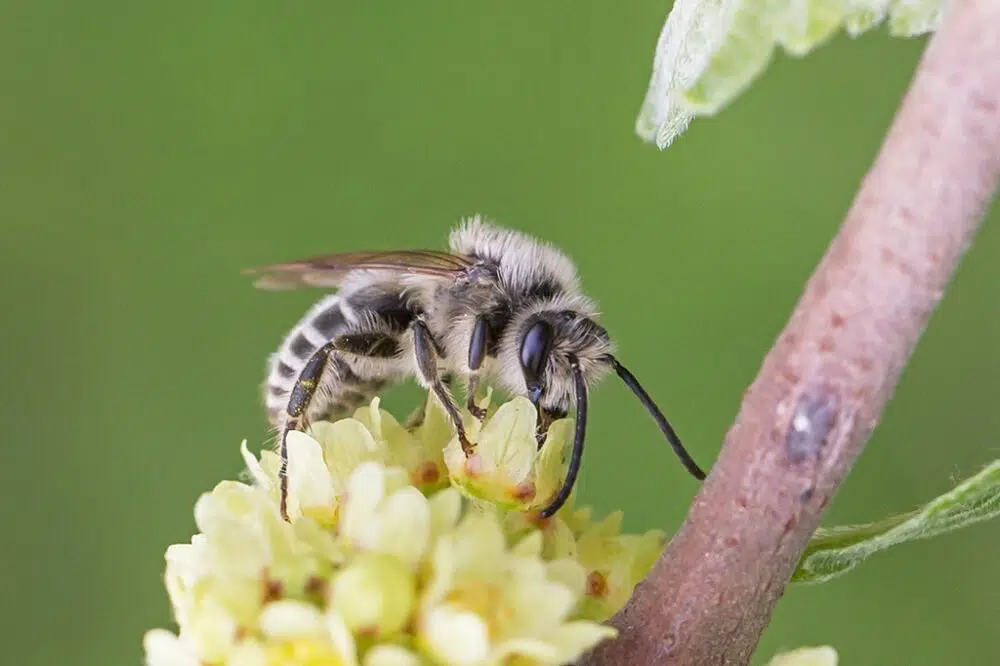
The Unequal Cellophane Bee (Colletes inaequalis) has a flight period between April and May. These bees are often seen around maple trees and willows.
Females grow to a size between 9 and 13mm while males grow to a maximum size of 10mm.
16. Lemon Cuckoo-Bumble Bee

The Lemon-colored Bee species (Bombus citrinus) is known for its invasive behavior. Bee of the species is known for taking over entire bee nests by killing the queen and its eggs.
Lemon Cuckoo-Bumble Bees aren’t the most efficient pollinators. However, they play a minor role in pollinating thistle, aster, and blazing stars.
Native to the US, the species is mostly seen as a parasite species of Common Eastern Bumble Bee and Half-Black bumble bee species.
Its parasitic behavior is most prevalent in August-September.
17. Modest Masked Bee

The Modest Masked Bee (Hylaeus modestus) is one of the small species in New York. These bees grow to a maximum size of 7mm.
These bees are identified by an almost black body with small yellow spots on the head and thorax.
Active between May and September, the bees also have a pollination role. They are general pollinators as they visit multiple families of flowers.
18. Texas Leaf-cutter Bee
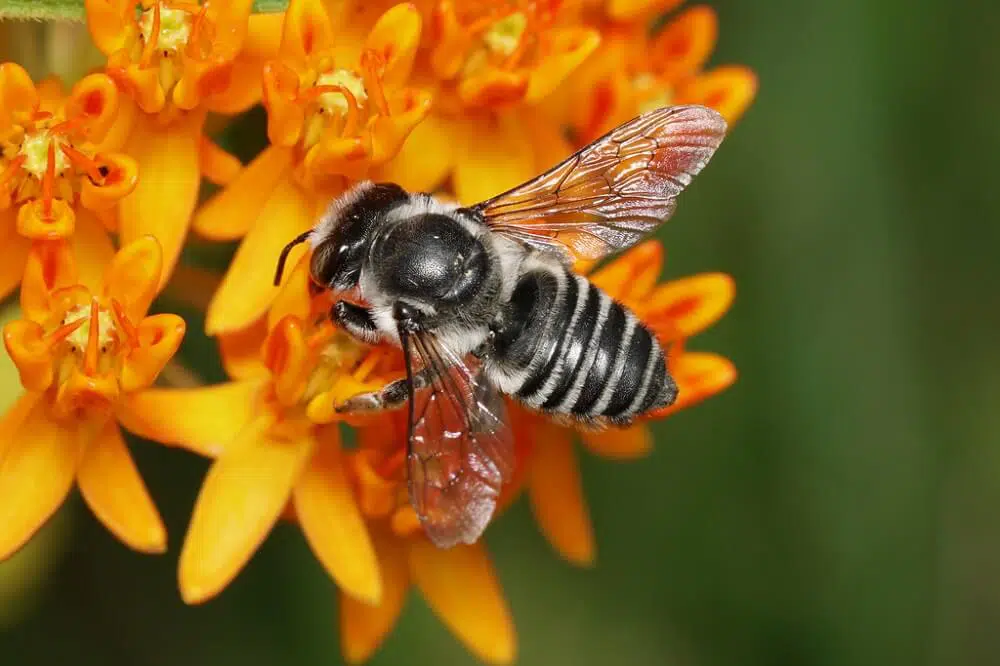
This species (Megachile texana) is part of the Megachilegenus. These bees are identified by a black body with white hairs.
Texas Leaf-cutter bees grow to a size of up to 13mm.
They nest underground with protected entrances normally found under rocks or next to rocks or walls.
Texas Leaf-cutter bees can also nest in existing cavities. They cut leaves which they use as fiber to build nests cells.
Sealed cells of the nest are made for their eggs. Pollen and nectar are added to each cell before sealing.
19. Flat-tailed Leaf-cutter Bee

The Flat-tailed Leaf-cutter Bee (Megachile mendica) also creates cells out of leaf fibers similar to the Texas Leaf-cutter bee.
This species has been first discovered in 1878. It’s common in New York and neighboring areas such as Maryland.
Bees of the species are identified by a black body with white or yellow hairs on the abdomen. It has no hairs on the thorax.
The species is attracted to asters, long-neck flowers, and sunflowers.
20. Silky Striped Sweat Bee

These bees (Agapostemon sericeus) are common on lawns and areas with tall grass. Part of the sweat bee species, these bees are attracted to sweat and they follow people around.
The most common place to see around New York is homes and parks that are frequently watered as they prefer high most environments.
Identification is based on their distinct metallic-green body. These bees have translucent brown wings with brown veins.
They have brown hairy legs and black antennae.
21. Yellow-banded Bumble Bee

The Yellow and Black Bee species (Bombus terricola) have an important role in pollinating wildflowers. It has been used commercially for the pollination of blueberries, raspberries, and cranberries.
Outside of New York, this species is used on alfalfa and potato crops.
While adapted to urban living, these bees are reducing in numbers across New York due to excessive urbanization. Several parasites including Physocephala are also responsible for the decline of the Yellow-banded Bumble bee.
Pollination is an important benefit of these bees, however. While they don’t visit as many flowers per day as other bee species, Yellow-banded Bumble Bees are known to visit up to 21 flowers per minute.
22. Dark-veined Longhorn Bee
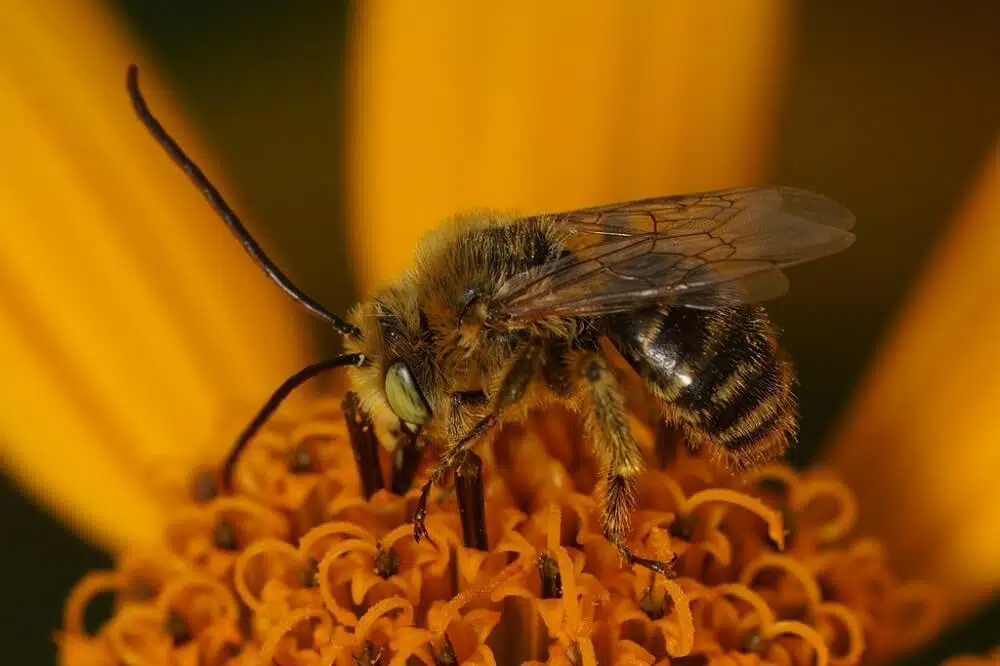
Part Melissodes family, the Dark-veined Longhorn Bees (Melissodes trinodis) grow to an average size. Females are larger than males growing between 11 and 12mm as adults.
Males grow to a maximum body length of 9 to 11mm.
The species is characterized by brown veins on the wings and long black antennae. The thorax is yellow-brown, covered in short hairs. The abdomen is striped.
Orange hairs are further distinguishable on the head of these bees.
23. Golden Sweat Bee

The Golden Sweat Bee (Augochlorella aurata) is identified by its small green body. These bees mostly grow to a size of up to 7mm.
Known for ground-level nesting, the bees emerge in the spring when the surviving overwinter males and females found a nest.
The first broad of Golden Sweat Bees emerged at the beginning of the summer. A second broad emerged in mid-summer.
Some variations from these habits are possible. Data suggests these bees can separate from a nest completely living solitary lives in adulthood.
The Golden Sweat Bee has an important role in pollinating flowers in New York parks and gardens. Wild roses, goldenrod, and wild mint are among its favorites around the city.
These bees also have many predators around New York. Robber flies, spiders, and some birds are seen as their common enemies.
24. Half-black Bumble Bee

The Half-black Bumble Bee (Bombus vagans) gets its name from its dual color body. It has a yellow and black section.
The thorax and the first 2 segments of the abdomen are yellow while the rest of the abdomen is black.
Bees of the genus are known to live at ground level where they have solitary nests.
The preferred habitat is rich in flowers and trees, particularly fruit trees.
The highest chances of seeing Half-black bumble bees are around red clovers and thistle. These are areas where worker bees are visible.
Queen Half-black Bumble Bees aren’t pollinating the same flowers and trees. Queens are often seen on plum and apple trees.
Half-black Bumble Bees emerge late in the season, unlike most other species in New York. They’re first seen at the end of May.
25. Confusing Furrow Bee

Also known as the Southern Bronze Furrow Bee, the Confusing Furrow Bee (Halictus confusus) is a yellow and black eusocial bee.
Known to forage clover, these bees are part of provisioning species that take care of their brood.
Bees collect pollen which is then provisioned for broods in the nest.
These bees have many predators. In New York, they face predatory behavior of crab spiders.
Ants are also seen as predators, especially when it comes to the damages they create to nests.
Further Reading: